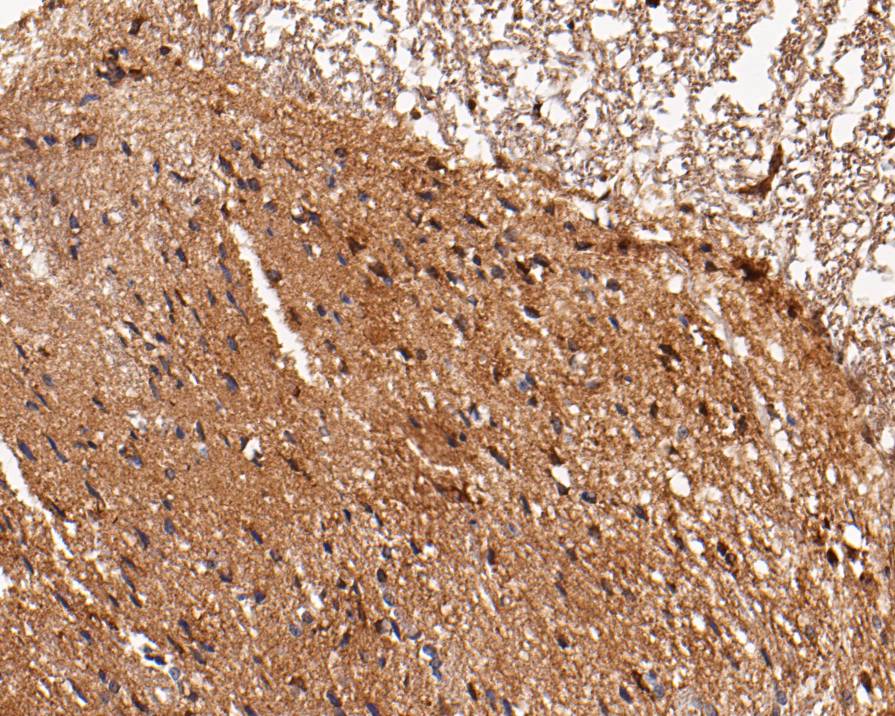LGI1 Rabbit Polyclonal Antibody

cat.: ER1901-57
| Product Type: | Rabbit polyclonal IgG, primary antibodies |
|---|---|
| Species reactivity: | Human, Rat |
| Applications: | WB, IF-Cell, IHC-P |
| Clonality: | Polyclonal |
| Form: | Liquid |
| Storage condition: | Store at +4℃ after thawing. Aliquot store at -20℃. Avoid repeated freeze / thaw cycles. |
| Storage buffer: | 1*PBS (pH7.4), 0.2% BSA, 50% Glycerol. Preservative: 0.05% Sodium Azide. |
| Concentration: | 1ug/ul |
| Purification: | Immunogen affinity purified. |
| Molecular weight: | Predicted band size: 64 kDa |
| Isotype: | IgG |
| Immunogen: | Synthetic peptide within rat LGI1 aa 200-250. |
| Positive control: | Rat brain tissue lysates, rat spinal cord tissue, rat brain tissue, rat cerebellum tissue, SH-SY5Y. |
| Subcellular location: | Secreted, synapse. |
| Recommended Dilutions:
WB IF-Cell IHC-P |
1:500 1:200 1:50 |
| Uniprot #: | SwissProt: O95970 Human | Q8K4Y5 Rat |
| Alternative names: | ADLTE ADPAEF ADPEAF Epitempin 1 EPITEMPIN Epitempin-1 EPT ETL1 IB1099 leucine rich glioma inactivated 1 Leucine rich glioma-inactivated protein 1 Leucine-rich glioma-inactivated protein 1 LGI1 LGI1_HUMAN OTTHUMP00000020121 OTTHUMP00000020122 |
Images

|
Fig1: Western blot analysis of LGI1 on rat brain tissue lysates. Proteins were transferred to a PVDF membrane and blocked with 5% BSA in PBS for 1 hour at room temperature. The primary antibody (ER1901-57, 1/500) was used in 5% BSA at room temperature for 2 hours. Goat Anti-Rabbit IgG - HRP Secondary Antibody (HA1001) at 1:200,000 dilution was used for 1 hour at room temperature. |

|
Fig2: Immunohistochemical analysis of paraffin-embedded rat spinal cord tissue using anti-LGI1 antibody. The section was pre-treated using heat mediated antigen retrieval with Tris-EDTA buffer (pH 9.0) for 20 minutes.The tissues were blocked in 5% BSA for 30 minutes at room temperature, washed with ddH2O and PBS, and then probed with the primary antibody (ER1901-57, 1/50) for 30 minutes at room temperature. The detection was performed using an HRP conjugated compact polymer system. DAB was used as the chromogen. Tissues were counterstained with hematoxylin and mounted with DPX. |

|
Fig3: Immunohistochemical analysis of paraffin-embedded rat brain tissue using anti-LGI1 antibody. The section was pre-treated using heat mediated antigen retrieval with Tris-EDTA buffer (pH 9.0) for 20 minutes.The tissues were blocked in 5% BSA for 30 minutes at room temperature, washed with ddH2O and PBS, and then probed with the primary antibody (ER1901-57, 1/50) for 30 minutes at room temperature. The detection was performed using an HRP conjugated compact polymer system. DAB was used as the chromogen. Tissues were counterstained with hematoxylin and mounted with DPX. |

|
Fig4: Immunohistochemical analysis of paraffin-embedded rat cerebellum tissue using anti-LGI1 antibody. The section was pre-treated using heat mediated antigen retrieval with Tris-EDTA buffer (pH 9.0) for 20 minutes.The tissues were blocked in 5% BSA for 30 minutes at room temperature, washed with ddH2O and PBS, and then probed with the primary antibody (ER1901-57, 1/50) for 30 minutes at room temperature. The detection was performed using an HRP conjugated compact polymer system. DAB was used as the chromogen. Tissues were counterstained with hematoxylin and mounted with DPX. |

|
Fig5: ICC staining of LGI1 in SH-SY5Y cells (green). Formalin fixed cells were permeabilized with 0.1% Triton X-100 in TBS for 10 minutes at room temperature and blocked with 10% negative goat serum for 15 minutes at room temperature. Cells were probed with the primary antibody (ER1901-57, 1/200) for 1 hour at room temperature, washed with PBS. Alexa Fluor®488 conjugate-Goat anti-Rabbit IgG was used as the secondary antibody at 1/1,000 dilution. The nuclear counter stain is DAPI (blue). |
Note: All products are “FOR RESEARCH USE ONLY AND ARE NOT INTENDED FOR DIAGNOSTIC OR THERAPEUTIC USE”.